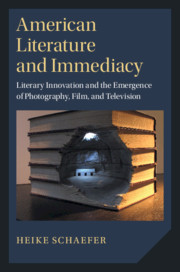 American Literature and Immediacy
American Literature and Immediacy from Part III - Literary Immediacy and Television
Published online by Cambridge University Press: 19 December 2019
The conclusion comments on the cultural functions that experiences of immediacy possess and outlines the productive contributions that the academic study of literary immediacy can make to literary and cultural studies, especially if it approaches literature from a comparative media perspective. The chapter summarizes that American Literature and Immediacy explores literary narratives of new media encounter, and the stylistic and thematic innovations they inspired, to show that American literary culture absorbs media cultural changes as it participates in the pervasive cultural quest for increased immediacy. The book describes how American writers compared the immediacy effects of photography, film, and television to literature’s representational possibilities to re-envision the imaginative and critical role that literary practice could play in a culture increasingly shaped by mass media. The conclusion also discusses the use of voice recognition software by the novelist Richard Powers and cites his compositional strategy as an example of how contemporary writers continue to successfully appropriate new media technologies in search of immediacy, full expression, and literary innovation.
To save this book to your Kindle, first ensure no-reply@cambridge.org is added to your Approved Personal Document E-mail List under your Personal Document Settings on the Manage Your Content and Devices page of your Amazon account. Then enter the ‘name’ part of your Kindle email address below. Find out more about saving to your Kindle.
Note you can select to save to either the @free.kindle.com or @kindle.com variations. ‘@free.kindle.com’ emails are free but can only be saved to your device when it is connected to wi-fi. ‘@kindle.com’ emails can be delivered even when you are not connected to wi-fi, but note that service fees apply.
Find out more about the Kindle Personal Document Service.
To save content items to your account, please confirm that you agree to abide by our usage policies. If this is the first time you use this feature, you will be asked to authorise Cambridge Core to connect with your account. Find out more about saving content to Dropbox.
To save content items to your account, please confirm that you agree to abide by our usage policies. If this is the first time you use this feature, you will be asked to authorise Cambridge Core to connect with your account. Find out more about saving content to Google Drive.